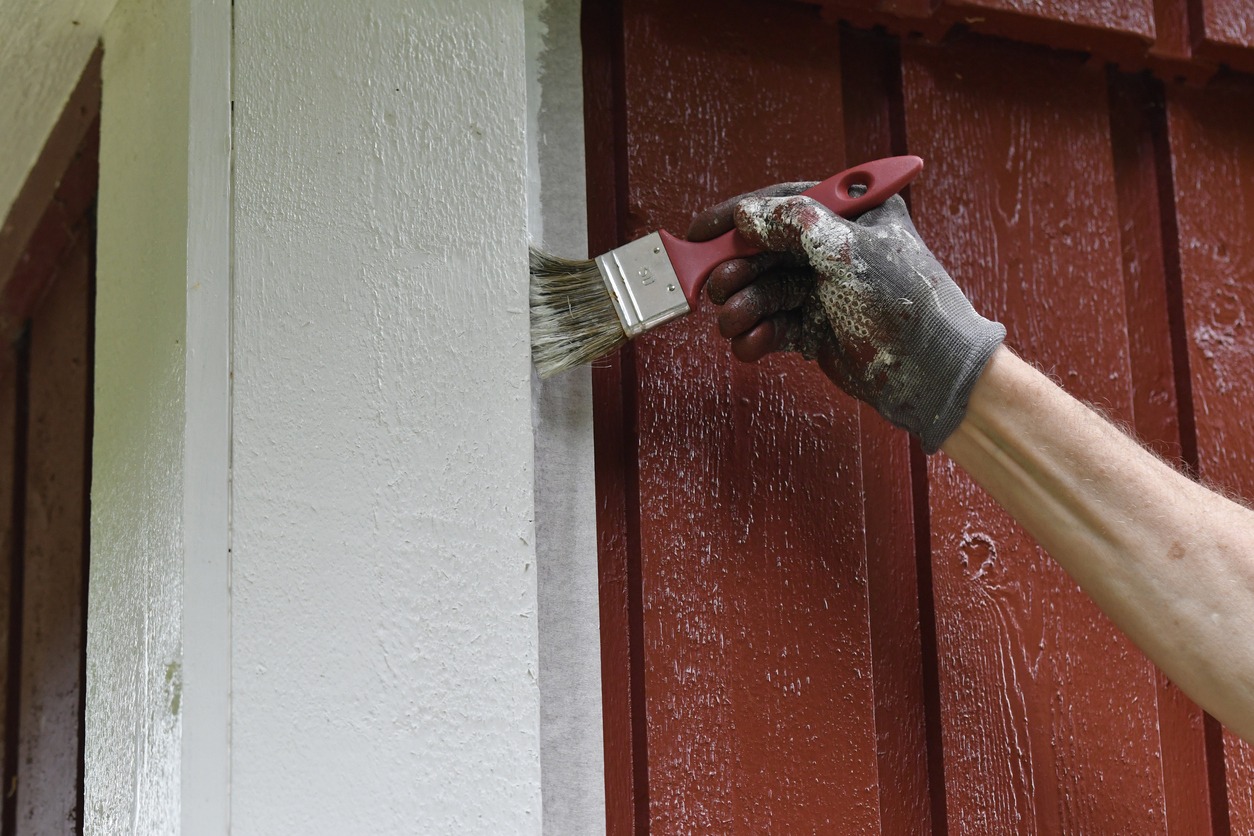Your home’s exterior is the first thing visitors and passers-by notice. If your home hasn’t seen new paint in years, it’s time to update it with cleaning, repairs, and, of course, a fresh coat of paint! Exterior painting is not only for aesthetic purposes, but it also has practical benefits. Indeed, it is an essential part of home maintenance.
The benefits of exterior painting in your home
Painting the exterior of a home offers numerous benefits that extend beyond mere aesthetics. Here are some of the key advantages:
1. Enhanced curb appeal
- Aesthetic improvement – A fresh coat of paint can dramatically improve the appearance of your home, making it look well-maintained and inviting.
- Increased property value – Homes with a well-painted exterior often have a higher market value, which can be beneficial if you plan to sell in the future.
2. Protection against the elements
- Weather resistance – Quality exterior paint acts as a protective barrier against rain, snow, sleet, and sun, helping to prevent weather-related damage.
- Moisture barrier – Properly applied paint helps to keep moisture out, reducing the risk of mold, mildew, and wood rot.
- UV protection – Paint with UV-resistant properties can protect your home from sun damage, preventing the fading and deterioration of exterior materials.
3. Maintenance and longevity
- Preventive maintenance – Regular painting can help identify and address minor repairs before they become major issues. This includes spotting areas of wood decay, water stains, or insect damage.
- Extended lifespan of materials – By protecting the exterior surfaces, paint helps to extend the life of siding, trim, and other materials, reducing the need for costly repairs or replacements.
4. Improved energy efficiency
- Reflective properties – Certain types of exterior paints can reflect more sunlight, keeping your home cooler in the summer and reducing the strain on your air conditioning system.
- Insulation enhancement – Some paint products offer insulating properties that can help maintain interior temperatures, contributing to overall energy efficiency.
5. Pest prevention
- Insect deterrent – A well-maintained paint job can help deter insects such as termites and carpenter ants from damaging your wood structures.
6. Health benefits
- Mold and mildew prevention – Paint will help keep moisture out and prevent the growth of mold and mildew, which can be harmful to health.
- Improved air quality – Modern paints often contain low or zero VOCs (volatile organic compounds), improving air quality and making it safer for residents.
7. Personalization and Expression
- Customization – Painting allows homeowners to express their personal style and preferences, creating a unique look that reflects their personality.
- Neighborhood standards – Maintaining a well-painted exterior can help uphold or improve the overall appearance of a neighborhood, fostering a sense of community pride.
8. Regulatory compliance
- HOA requirements – In some communities, homeowners’ associations (HOAs) have specific guidelines regarding exterior paint colors and maintenance. Keeping your home painted can ensure compliance with these regulations.
9. Psychological benefits
- Sense of pride – A well-maintained home can give homeowners a sense of pride and satisfaction.
- Stress reduction: Knowing that your home is protected and looks its best can reduce the stress associated with property maintenance.
Compliance with a homeowners association (HOA) and regulations

If you’re living in a village, subdivision, or community with a homeowners association (HOA), you must be aware of its painting guidelines.
The guidelines may vary depending on the village or community you live and your HOA, but they generally have the following elements:
1. Approval process:
- Submission of request: Homeowners often need to submit a request for approval before starting any exterior painting. This request might include details like the proposed colors, type of paint, and areas to be painted.
- Review period: The HOA usually has a specified period during which they will review and approve or deny the request. This can vary from a few days to weeks.
2. Color palette:
- Pre-approved colors: Many HOAs have a list of pre-approved colors that homeowners must choose from. These colors are often selected to maintain a cohesive and harmonious look within the community.
- Color schemes: There may be specific guidelines on how colors should be combined (e.g., trim vs. main body of the house).
3. Consistency and compatibility:
- Neighborhood Harmony: The chosen colors should be compatible with the overall aesthetic of the neighborhood and should not clash with adjacent homes.
- Architectural style: The colors should complement the architectural style of the home.
4. Maintenance of historical integrity:
- In communities with historical significance, additional guidelines may be established to preserve the homes’ historical integrity, which could restrict certain colors and finishes.
5. Quality of materials:
- Paint type: Guidelines might specify the type of paint that must be used (e.g., weather-resistant, eco-friendly).
- Professional standards: Professionals may be required to do the painting to ensure quality and longevity.
6. Timing and logistics:
- Permissible hours: Restrictions on the hours during which painting can be done to minimize noise and disruption.
- Debris and clean-up: Proper disposal of materials is also an HOA requirement, as is clean-up of the work area to maintain community aesthetics and safety.
7. Penalty for non-compliance:
- Fines and repainting: Homeowners who paint their exteriors without approval or in non-compliance with guidelines may face fines and could be required to repaint their homes at their own expense.
8. Regular maintenance:

- Repainting schedule: Some HOAs might have guidelines on how often homes should be repainted to ensure the community remains well-maintained.
Examples of specific guidelines
- Neutral and earth tones: Many HOAs prefer neutral or earth tones that blend well with the environment.
- No bright or fluorescent colors: Bright, neon or fluorescent colors are usually prohibited.
- Trim and accent colors: There may be specific rules about which colors can be used for trim, doors, shutters, and other accent areas to ensure they complement the main house color.
Enforcement
- Inspections: The HOA may conduct regular inspections to ensure compliance with painting guidelines.
- Reporting: Homeowners may be required to report the completion of painting projects for final inspection and approval.
These guidelines can vary significantly depending on the specific HOA and community, so it’s important for homeowners to review their HOA’s governing documents, such as the Covenants, Conditions, and Restrictions (CC&Rs), Architectural Guidelines, and other related policies.
Conclusion
Regularly painting your home’s exterior is a worthwhile investment that provides a wide range of benefits. It enhances your home’s curb appeal, increases property value, protects your home’s surface against the elements, and improves energy efficiency. Exterior painting also helps you comply with your HOA’s guidelines, maintaining the overall appearance and property values within your village or community.
Exterior painting is an essential aspect of home maintenance that ensures your home remains beautiful, safe, and durable for years to come. If you want a professional-looking finish for your home’s exterior without bothering with all the work and hassle, contact Custom Painting, Inc.! Call us at 925-294-8062 or message us here. We will be glad to talk about your exterior home painting project and give you a free estimate!

